Categories: Featured Articles » Sources of light
Number of views: 15180
Comments on the article: 6
Types of lamps for home lighting - which are better and what is the difference
Which lamps are better for home lighting? LED, fluorescent, halogen or incandescent? What are the advantages of some and the disadvantages of others? How economical is it to use lamps of one type or another? Let's try to figure it out.
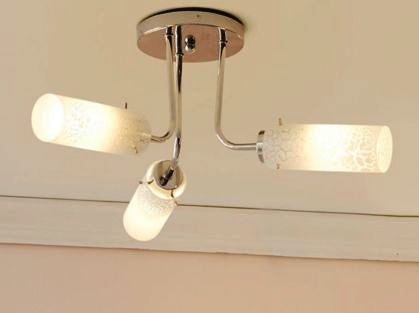
Incandescent lamps
The most common type of lamp in homes is still incandescent lamps. To this day, they are available in various capacities, come in a variety of sizes and shapes, suitable for installation in almost any lighting device, whether it be a lamp, a night lamp or a chandelier.
Incandescent lamp - the simplest electric light source. It consists of a sealed transparent evacuated flask, a metal base, and a spiral is installed inside the flask - a tungsten filament.
During the operation of the lamp, an electric current flows through its tungsten filament, just causing the filament to become white. That is, the light in such a bulb is obtained due to a current-heated tungsten filament, which emits visible light. At the same time, only 20% of all energy supplied to the light bulb is accounted for, the remaining 80% is due to heating. You can basically say that an incandescent lamp is a heating device that glows well during operation.
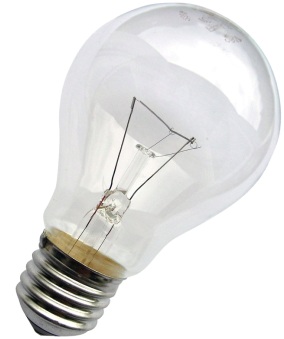
Of course, incandescent lamps are rapidly leaving the market, their production is not as intense as before, but the cost of incandescent lamps is the lowest in comparison with other types of lamps.
Other types of lamps are more economical in operation than incandescent lamps, some are more economical up to 10 times, and even more reliable at times, but the cost of incandescent lamps is very low compared to other types. Therefore, those people who do not think about a long-term payback continue to buy good old incandescent lamps for a penny, although they actually incur losses by overpaying for the electricity spent on lighting for many months.
Halogen lamps
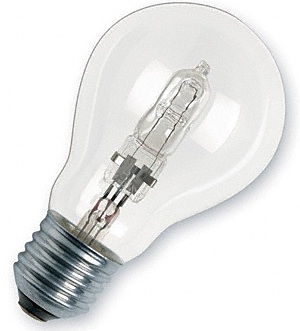
Advanced type of incandescent lamp - halogen lamp. Here, a tungsten filament heated by current, but placed in a flask with halogen vapors, also serves as a light source. Luminous efficiency is increased thanks to halogens, and the efficiency increases slightly in this regard.
The lamp life also increases - if a regular bulb lasts about 1000 hours, then a halogen one - 2-3 times longer. Halogen lamps are smaller in size at the same power but with greater light output than conventional bulbs with filament. Therefore, halogen lamps are widely used in small recessed home luminaires and in automotive optics (see - Types of halogen lamps and their features).
Fluorescent lamps
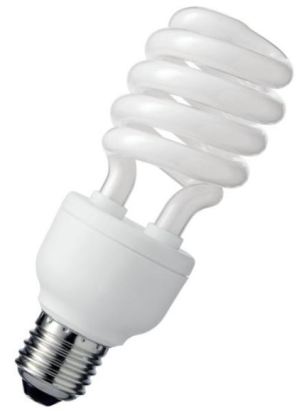
Energy Saving Fluorescent Tubes - the next step in the evolution of lighting devices. It is compact fluorescent lamps (CFLs) that are today called "energy savers." Their consumption is much lower than that of incandescent and halogen lamps with a similar luminous flux.
Since 2010-2011, the active introduction of fluorescent lamps in home lighting systems has begun. And if earlier fluorescent lamps in the form of tubes were aesthetically suitable for industrial premises and offices equipped with special lamps for such tubes, then fluorescent lamps under a standard base (like a home incandescent lamp) began to be suitable for residential premises - I unscrewed the incandescent lamp and put it in this the same cartridge is an energy-saving fluorescent lamp, and no difficulties.
The basis of the functioning of a fluorescent lamp is an electric discharge in mercury vapor.The ultraviolet radiation that occurs when this is converted into visible light due to the phosphor deposited on the inner walls of the bulb. As a phosphor, special compositions such as calcium halophosphate are used as part of a mixture with auxiliary components.
The luminous efficiency of fluorescent lamps is approximately 5 times higher than that of incandescent lamps, and the life of a high-quality fluorescent lamp can be measured in thousands of hours. Nevertheless, even fluorescent lamps are not by far the most effective light sources for homes, not to mention the problem of disposing of faulty lamps with mercury vapor inside.
LED lamp
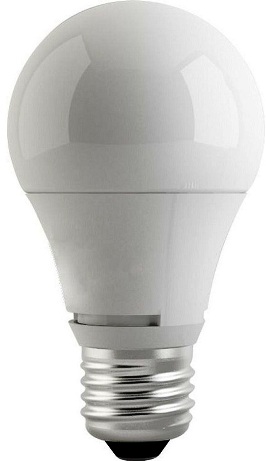
The crown of evolution of light sources today is LED lamps, the most energy-efficient. Further, we will clearly compare the characteristics of lamps of various types, and this will become more obvious. LEDs are used here as light sources, so the design of an LED lamp is somewhat more complicated than that of an incandescent lamp, and its cost is therefore much higher.
Nevertheless, LED lamps quickly pay off during operation, and much earlier than their service life, which amounts to tens of thousands of hours, expires. At the same time, LED lamps are extremely safe. They do not have a glass flask that can burst, causing harm to human health, for example, cutting it, like there are no mercury vapors and no other harmful components, that is, environmental safety is also ensured. Problems with disposal, if anything, will not arise at all.
Comparison of the parameters of lamps of various types
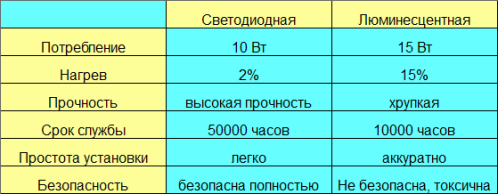
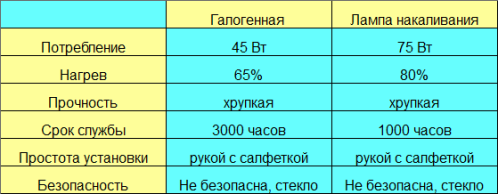
Power
From the table above it can be seen that with the same luminous flux given out, lamps of different types consume different electric power, and this power differs significantly. Especially pay attention to the fact that the LED lamp in comparison with an incandescent lamp consumes almost 8 times less electricity, and at the same time gives the same amount of light. Imagine how this will affect electricity bills. As for the compact fluorescent lamp, it is 1.5 times inferior to the LED.
See also - The ratio of the power of lamps of various types
Efficiency
Do we need heating from a light bulb? Of course not, because there is a heating system for heating the home. It turns out that the more the lamp heats up - the more energy is consumed not in a targeted way, because we need the lamp for lighting, and not for heating. Meanwhile, an incandescent lamp translates 80% of the power consumption into heat. Halogen warms up to 65%. Luminescent by 15%. LED only 2%.
Hull strength
As for durability, incandescent and halogen lamps have bulbs made of fragile thin glass, and if you drop such a lamp, you will immediately have to notice small fragments. Fluorescent tubes are no less fragile. In addition, there are mercury vapors, toxic vapors that will come out if the flask is accidentally broken, and the room will need to be ventilated and sanitized.
LED lamps are in a winning position, they are not afraid of shock, the bulb is usually made of polycarbonate, there are no harmful gases. If you accidentally drop the LED lamp, then it most likely will not happen, unless you should drop it from a high height, so as not to damage the inside.
Life time
In terms of service life, LED lamps are definitely superior to any others: on average, LEDs will last 40 times longer than incandescent lamps, they can be considered eternal in this regard. Some manufacturers directly write on the package that the lamp is guaranteed to work for 30 or 40 years. Fluorescent lamps are slightly inferior, their manufacturers are confident that the lamp will last 10 years. As for the incandescent lamp, its average term for the conditions of current electric networks is 1 year.
Easy replacement
To replace the bulb, it is enough to unscrew it from the cartridge and screw a new one. But halogen lamps can not be screwed on horribly.First of all, you need to understand that a halogen lamp is very hot during operation, for example, a 40-watt lamp is heated to 250 ° C. No, we are not talking now about the need to wait for the lamp to cool before unscrewing it, something else is important here.
When installing a new halogen lamp, your hands should be extremely clean, and it’s better to use a napkin in general, because any greasy stain on the bulb will surely burn out and a burn mark will appear, the light will be spoiled. Another such trace will lead to local overheating of the flask, and it may crack. LED and fluorescent lamps do not heat up so much, so they can be twisted and screwed even with bare hands.
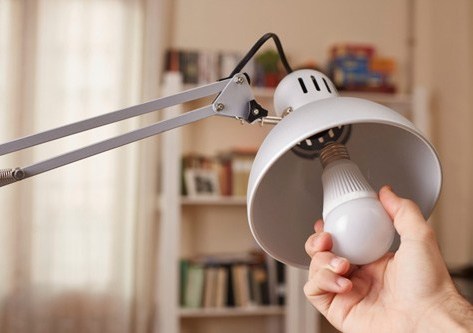
Safety aspects
Speaking of security, let's look at a couple of aspects. Firstly, the quality of light. Light quality is best for incandescent, halogen and LED lamps. However, fluorescent lamps have harmful flickering, irritating the nervous system, in addition color rendering of such lampsusually distorted. Secondly, the content of mercury vapor is by no means in favor of fluorescent lamps. That is, for safety, everyone but luminescent wins.
What is the result
The result is clear. From the point of view of efficiency and safety, LED bulbs come first, followed by incandescent bulbs (safe, but voracious), and finally fluorescent bulbs (flicker, poor colors, contain mercury).
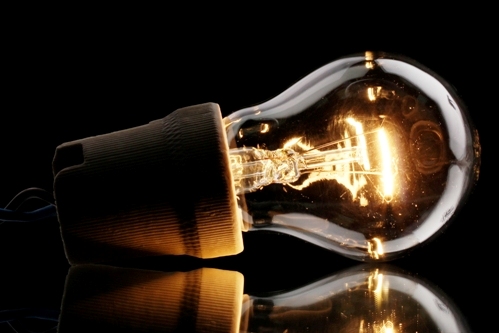
Consider the financial side
Let's say 15 incandescent lamps of 75 watts are installed in the apartment, which you want to replace with LED ones. Let the lamps burn for about 4 hours a day. That means that a month falls on lighting: 15 * 75 * 4 * 30 = 135 kW-hours. Suppose the cost of electricity in your region is 5 rubles per 1 kWh. This means that in a month only for the light runs 675 rubles.
If we switch to LED lamps with a power 7.5 times less (as noted above), then the bill will be only 90 rubles. Let the replacement of lamps cost you 3450 rubles, then with a difference in accounts of 585 rubles, the lamps will pay off in half a year! And this is with the estimated price of an LED lamp of 230 rubles. The benefits are obvious. If we now take into account that LED lamps will last 30 years, then you yourself understand what enormous savings we are talking about.
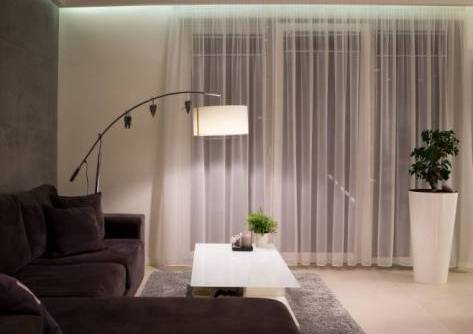
Three main advantages of LED lamps
-
LED lamps are eternal in comparison with incandescent lamps that quickly burn out
-
LED lamps quickly pay off despite the high cost.
-
LED lamps are environmentally friendly and not easy to break.
Best for home lighting - LED bulbs
In conclusion, we can definitely say that LED lamps are best suited for home lighting from all points of view. Even if at first glance they seem expensive, consider the payback. The more lighting fixtures in your home, the faster the new bulbs will pay off.
If you leave it as it is, it turns out that the electricity bills spent on inefficient lighting will eat a lot more money in total than it would take to spend only once on the purchase of new efficient light bulbs.
See also on this topic: Classification and labeling of LED lamps andHow to choose the right LED lamp
See also at e.imadeself.com
:
